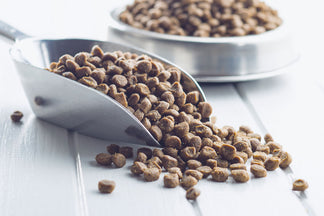October 8th is the 2014 National Pet Obesity Awareness Day in the United States. This day was created by the Association for Pet Obesity Prevention (APOP) to help raise awareness of the pet obesity problem we have in the U.S. It also provides a perfect opportunity to shed some light on the financial cost to owners of overweight pets.
As if shortened lifespan and lower quality of life are not reason enough to keep a pet trim, perhaps the realization of how costly it can be to have an overweight pet can be the impetus to change pet owner behavior for the betterment of their pet and their bank account.
Pet obesity is a major problem in the U.S. According to the 2013 APOP survey, almost 53% of dogs and 58% of cats in the U.S. are overweight or obese. Perhaps even worse, 17% of all dogs and a whopping 26% of all cats are considered obese. Studies in some other countries, like the United Kingdom, show that this problem exists globally as well.
The Financial Costs of Having an Overweight Pet
In 2009, a study at the Michigan State veterinary hospital and funded by Hill’s Pet Nutrition, was conducted to determine the annual treatment costs associated with common canine and feline diseases and disorders. The results are shown in the Tables below.
Annual Costs of Common Canine Diseases
|
Disorder/Disease |
Average Cost |
|
Heart disease |
$1,912 |
|
Hypertension |
$1,700 |
|
Osteoarthritis |
$1,656 |
|
Cancer |
$2,447 |
|
Diabetes |
$1,108 |
|
Pancreatitis |
$1,422 |
|
Obesity + ruptured ACL |
$2,367 |
|
Chronic kidney disease |
$1,823 |
Annual Costs of Common Feline Diseases
|
Disorder/Disease |
Average Cost |
|
Heart disease |
$1,065 |
|
Hypertension |
$1,241 |
|
Osteoarthritis |
$286 |
|
Cancer |
$994 |
|
Diabetes |
$860 |
|
Pancreatitis |
$1,483 |
|
Chronic kidney disease |
$1,065 |
|
Hyperthyroidism |
$1,401 |
The cost to treat a pet with any one of these disorders is obviously significant. These are estimated annual costs, which means that a pet’s total treatment costs over a lifetime could easily exceed $10,000 depending on the disease and age at diagnosis. Even worse, an overweight pet might develop multiple diseases due to their weight problem raising the treatment costs even higher.
An overweight pet is more susceptible to disease and orthopedic disorders. In fact, virtually all of the conditions listed above are more likely to occur in overweight pets than in properly weighing pets. According to APOP, the primary risks of overweight pets include:
- Heart and Respiratory Disease
- High Blood Pressure (hypertension)
- Osteoarthritis
- Many Forms of Cancer
- Insulin Resistance and Type 2 Diabetes
- Cranial Cruciate Ligament Injury (ACL)
- Kidney Disease
- Decreased life expectancy (up to 2.5 years)
Although pancreatitis is not on the APOP list, overweight pets have a higher risk factor for this than do healthy weight pets.
Steps to Keep your Pet Lean and Healthy
The decisions that you make about your pet’s food are the most important factors that will determine if your pet is overweight or not. First and foremost is how much you feed your pet. Overfeeding, pouring too much food and neglecting to take into account treats, is the single biggest driver of the pet obesity problem. Secondly, feeding your pet appropriate and high quality food will ensure that your pet is provided a balanced diet, free of fillers and potentially harmful artificial additives. The tips below will help you develop a food strategy that will keep your pet trim and healthy.
- Consult with your veterinarian to come up with a health assessment and target weight for your pet.
- Learn how many calories your pet needs each day. Your pet’s daily calorie requirement is primarily dependent on their size and level of activity.
- Learn how many calories are in your pet’s food and treats. Portion accordingly. The feeding instructions on most food labels are too general and not always appropriate for a specific pet.
- Understand the ingredients in your pet’s foods and how they might impact the protein to fat ratio in the food and avoid foods with unhealthy fillers or artificial additives. Most normal dogs and cats require a diet that is high in protein and fat. Unfortunately, many pet foods are high in carbohydrates. Also, many pet foods are laden with fillers or artificial additives that at best, provide little nutritional value and at worst, could be potentially harmful to your pet.
- Add moderate to high intensity exercise if possible each week. Although not directly related to the food decision, exercising your pet regularly is an important aspect of their overall health and body condition. Mix in higher intensity exercises once or twice a week if your pet is approved to do so by your vet. The higher intensity sessions can boost their daily calorie burn and also provide many other benefits to their body and mind.
- Observe your pet’s body condition and tweak your plan over time.
For those who want the convenience of automation and the peace of mind that their pet will be fed properly (even when the pet owner is away from home), the Petnet(io) SmartFeeder is built to provide pet owners with all of the above information and automatically create a customized and appropriate food strategy for their pet.
Related Articles
http://veterinarybusiness.dvm360.com/counting-cost-chronic-disease?rel=canonical

 Food
Food
 Food
Food
 Food
Food
